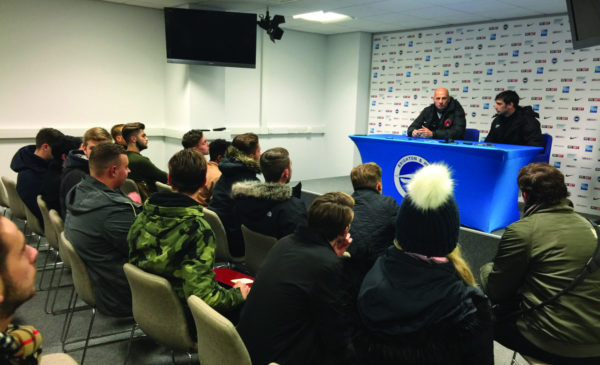Journalists covering sport have an opportunity to elevate their social status post COVID-19 – by making premium product – high quality journalism.
As society comes out of a period in which the reliability of news was critical for the wellbeing of the population, some attention may have turned to reengaging audiences who could have disconnected from the news. The digital age, together with sport journalists’ growing social responsibility, has offered the industry a chance to reengage the public and enhance its reputation in the post COVID-19 era.
Due to sport becoming an unavoidable contemporary part of society[i], sports journalists’ social responsibility has been uplifted. Journalists now have to encompass topics wider than the game itself. “You look at the situation between Chelsea, Russia and Roman Abramovich, it’s a story with politics at the heart of it, but you have sports journalists covering it, the role of a sports journalist now is so different,”[ii] Simon Collings, of the London Evening Standard, explained.
Technological advancements, the digital age and the fall of the print product have altered the ways in which readers receive their news and journalists practice journalism. Pay wall and subscription models are becoming more popular among the big players in the industry, alongside rising newsprint and energy costs making the print product look more unsustainable, as well as next generation technologies such as AI and the metaverse coming to the fore in the new year, the present and future of journalism looks unrecognisable. But after years of uncertainty in the news, this could be exactly what the industry needs.
The birth of 24-hour news saw anyone with a device connected to the internet, compulsorily being fed with news. Phone applications now offer a never-ending stream of notifications on current global affairs, many of which may hold no interest to the recipient. After years of uncertainty in the news, in a period where the news was critical to the publics well-being, it’s foreseeable that some interest and engagement in the news has been forgone.
I spoke with sports journalists from various generations on how the role of a journalist has transformed, the social responsibility they now hold, the importance of credibility in the modern era, the ethical barriers that come as a result of social media and digital news, the benefits of their own metrics, the change in consumers’ demands, the future of the industry, and how all of this can enable the industry to rediscover its human touch in the digital age following the pandemic.
As organisations have come to terms with the fact of there being more financial gain from pushing the journalism product online, rather than print, the industry has seen large focus on making an online, premium product. Sam Dean, of the Telegraph, one of the largest organisations to follow the modern pay wall subscription model, explained the challenges following a model like this ensue: “It has to be of a high standard and distinctive. There’s no point in us doing the same thing you see in the BBC or the Guardian because why would they pay when you can get it for free elsewhere, so that’s caused us to think a bit differently and creatively.”[iii] In January this year, the Telegraph reported that as of December 2021, they had 544,911 digital subscribers.[iv] Dean explained the methodology behind the obvious success of the model. “If a news story breaks, rather than just reporting on what’s happened, we would try and do some analysis with it or maybe a feature around it or an interview. Its more about making it an enriching experience for the reader.”[v]
Another poignant example of this new model for journalism is The Athletic, the Silicon Valley backed venture which upon formation co-founder Alex Mather vowed to “wait every local paper out and let them continuously bleed until we are the last ones standing”[vi]. Maybe a slightly dramatic message, but a sign of the vigour at which technology and digitality is sweeping not only through the industry, but society as a whole. Collings alluded to this idea. “I think certainly subscription journalism is the way a lot of places will go, partly because that’s how we as a society consume things now, people don’t mind paying for Netflix, Spotify and Amazon Prime, it’s like a monthly thing they forget. So I think that model which The Athletic and the Telegraph have will be what a lot of companies go towards.”[vii] As a society, consumption patterns are changing alongside demands, tasks as mundane as going to the shops are now digitalised, “technology is a prime mover of society and it makes social change inevitable.”[viii]
Alan Tovey, who was at the Telegraph for 25 years, explained that “the industry keeps up and is ahead to a certain extent”[ix] when asked about how journalism is practiced in the now digital nature society engulfs. Given the subscriptive nature of consumption in the modern day, Tovey’s words ring true. Raymond Boyle, a noteworthy scholar of sports media, technology, and their “symbiotic relationship”[x], somewhat predicted this dependability between society and devices, back in 2004. “Much will change over the coming years as mobile technologies become more deeply rooted in our everyday lives,”[xi] said Boyle.
Boyle was right, much did change, 2004 was the birth year of Facebook, Twitter didn’t exist, the number of worldwide users of the internet had grown by 52.9%[xii], Charles Watts, of Goal, told me that over his 21 years as a professional, digitalisation and social media has changed the landscape of journalism “beyond compare”. “Back then you’d go to matches and phone in match reports over the phone, Wi-Fi was non-existent at most grounds. It’s hard to even describe how different it is.”[xiii] For some within the industry who lived through the transition of priority (from print to online), it was not a straight-forward process. “Sports journalists experienced professional angst in the early transition to the internet, with these feelings being particularly acute for older members of the occupational community.”[xiv] Tovey, with his 25 years of experience in the profession, was able to recall witnessing these struggles first-hand, “I was okay, I grew up around computers, but for the older journalists I can vividly recall a few of them being strongly against the digital side of it, they really struggled at the start.[xv] Putting an alternative perspective on the flash, trendy, ‘shiny new toy’ a medium like Twitter can exemplify, it’s enlightening to think about the re-education a lot of the older journalists would’ve experienced.
Despite this, journalists now have a privilege those 20 years ago didn’t, analytical feedback of their own work, in the form of metrics such as page views, time spent on a page, retweets, likes etc. In a broad sense, technology has allowed for better, and more, analysis. “Monitoring online audience metrics can affect the gatekeeping process because it enables journalists to more accurately take the preferences of the audience into account.”[xvi] This accountability of pleasing the readers, based on what performs better ‘statistically’, has come at some price, but the consensus amongst interviewees was largely positive regarding personal metrics for journalists.
“It’s good to know what people are reading, liking and engaging with because we write for our readers, we write to be read, so if we’re not being read something needs to change.” Dean explained, before going on to consider the challenges faced for journalists in previous generations. “Before, with print, 20 years ago, people would never know how much their stuff is being read or what people thought about it, whereas now, you do know. If you know what people want, you can give them more of it.”[xvii]
If you were to tell the journalists of 30 years ago that they’d have real time statistics of their own work that would tell them how many people read each of their articles, they’d find it fairly profound. Sadjad Soltanzadeh, a researcher in the ethics and philosophy of technology, defined devices that are used to measure metrics such as page views, as “physical instruments that can be used for problem solving”[xviii]. This depiction demonstrates the reliance we as a society now hold on digital devices, and their importance on our daily routines. Sam Smith, of The Daily Express, alluded to this idea: “If there were to be some kind of cull where the government took away peoples’ phones and laptops, god knows how we’d cope.”[xix]
Collings revealed how those at The Standard used advanced metrics on original content, not only to see its popularity among readers, but also the most optimal time to post it online. “Around 18 months ago we started doing player ratings, they’ve gone down really well, traffics really high and you can also see where the traffic is coming from, you can see when the best time is to post.”[xx]
Outside of sport, the online product of journalism allows for stories from various corners of the industry to be time specific, allowing organisations to attack the intended target audience at the prime time. In regards of reengaging the public with the news, this modern innovation may aid this idea tremendously.
Watts shared his experiences on the ways in which different newsrooms hone in on the metrics, relative to the culture of the organisations. “When I was at Football London I took a lot more notice of it as it [Football London] was a start-up, it was new on the scene, very focused on page views, hits and exposure. We were constantly watching Chartbeat, which showed how many people were on the site at the current time, it was up on a big screen in the office. It was the same at Trinity in Reading before Football London, they were very much focused on that.”[xxi] But at Goal its slightly different, I’d get a weekly email of my metrics, then at the end of the month my manager would send me a chart of all my stories showing me which has got the most page views.”
Start-ups such as Football London putting an emphasis on the metrics makes sense, due to the fact that recent research has shown that news organizations are having metrics inform their editorial decisions, from news presentation (news placement, headline adjustment) to news production (expanding or following up heavily clicked stories)[xxii]. Therefore, newly founded pages would use the metrics to do some market research of sorts.
“The longer form pieces usually encourage people to stay and move around the site than if it’s just a very short, almost social media orientated story that may attract people quickly but may also lose interest quickly, so you kind of judge things in different ways. I think I get a lot more satisfaction knowing people have spent two and a half minutes on average reading a long feature I’ve done, than 2000 more people have read it, but they’ve basically read it for eight seconds and have just clicked on it because of the headline that someone has given it on the news desk.”[xxiii]
Metrics aren’t exclusive to article exposure, social media offers stats for journalists. “That’s one of the great things about social media today, you can look at the number of likes, retweets or shares you get”[xxiv] Dean explained. Those shares, likes, and comments have become the new indicators for the relevance of an issue[xxv].
Despite this, there is some indication from those within the industry that this inherent need for page engagements can lead some journalists down a dangerous path. “It can do you some harm if you’re always looking at how many people are viewing your stories. It can even lead to putting out crap stories because of it and stuff you wouldn’t normally put out but you’re thinking ‘God I’ve got to get something out, so I’m just going to put this out,’”[xxvi] Watts elaborated. Twitter has been suggested to lead journalists to surrender their independence to please their following, alongside contaminating a sports journalist’s news sense, due to publishing with the sole purpose of appeasing their audience.[xxvii]
‘Clickbait’ is a phrase which has grown autonomously with technology. However, it’s hard to ignore the indication that the analytical software which provides metrics on articles, has accelerated clickbait culture.
As journalists have access to a 24/7 stream of information on how well their work is performing, ethical challenges may arise. Collings recalled an example of this he came across. “A report came out that at The Telegraph, journalists were being ranked on how their articles were performing, I think that isn’t beneficial. If you start making journalists compete for page views and engagement, I don’t know if it sets the right culture. It comes a bit of a race to the top, which would by nature encourage things like clickbait maybe subconsciously.”[xxviii]
In an industry where “ethics has always been an issue”[xxix], according to Smith, the clickbait culture is a main driver of the negative side the digital age presents for journalism. Fundamentally, clickbait is essentially media groups yearning to draw more readers to their site. As large amounts of journalism online is free, organisations draw their revenue with site visits. In a role which has been so frequently scrutinised over the years, it is vital that quality isn’t being undermined. Credible journalists have to ensure that they are not pursuing “a never-ending quest for easy content in which attractive headlines trump journalistic content.”[xxx]
Smith was able to enlighten on the editorial process at the heart of the phrase. “At the Express and pretty much every news site on the internet will design their headline so people click on them. Every headline will be front loaded with key words.” Smith was eager to express his distain towards the idiom. “I’m not a massive fan of the word clickbait, because I think everything on the internet is clickbait in a way, it’s getting people to read.”[xxxi]
Upon conducting interviews, the two negative sides that stuck out as a result of the digital age were clickbait culture and the speed at which journalism is practiced, hindering accuracy.
Collings concludes: “People have got an insatiable desire for news; it does put a greater strain on accuracy.”[xxxii]
Tovey says that he and his colleagues described the Internet as a “TARDIS”, when he first got into the industry. Twenty-five or so years on, his analogy remains prevalent. With an ever-increasing amount of people online with an ability to practice journalism, accuracy can often be disoriented.
“I think there are some outlets and websites that wouldn’t have existed pre-internet, that thrive on being the quickest, they’re sometimes happy to put things out quickly, rather than ensuring it’s accurate,” Dean explained.[xxxiii]
Jeorge Bird, who has worked at various papers across London and boasts a Twitter following of over 60,000, told me about previous experiences relative to Dean’s point. “When I first started out, there was a big demand at some places to get stuff out first and fast, so I had to be careful.” Bird admitted to his struggles when beginning in the profession, “it was hard getting the balance right between quality and getting things out quickly.”[xxxiv]
This modern challenge in the industry offers an opportunity for consumers to distinguish the news organisations between what they prioritise, speed or accuracy. With the growing popularity of subscription-based models, it gives an indication on where the preference of the consumer lies.
Tovey was able to enlighten on the difference in editing between now and when he started his professional career, suggesting there’s now a larger pressure on initial accuracy of stories. “20 or so years ago, news was a bit slower, stories went through a lot of eyes, there was a thorough process involved. Now, the deadline is now, so it doesn’t have as many layers that it has to go through. So, I think the onus is to now get it right the first time, because it can be decimated so quickly.”[xxxv]
Being first, being right, it’s a hazy area in the industry, which journalists have to be held accountable for. “I’d much rather be second and accurate than first and wrong”, was the general gist between both Watts and Dean when discussing the quandary. Between them, they have over 350,000 followers on Twitter, vindicating their moral stance.
Social media, in particular apps like Twitter, can magnify a journalist’s reputation, be it good or bad. “You get things wrong and people notice. Readers, especially in the football world, are a very critical bunch,”[xxxvi] Dean explained. This ever-growing critical analysis of journalists didn’t exist to such an extent prior to social media, offering journalists an opportunity to establish themselves as reliable and credible gatekeepers in the digital age.
“When everybody can put out simple information without any great effort, high-quality content produced by journalists is still very important.”[xxxvii]
After long term concerns by some over the nature of sports journalists’ value and distinctiveness, and whether their authority and privilege in society are warranted in the digital age[xxxviii], hearing the views of those at the heart of the profession on the matter was able to give a clearer picture on the future and “differentiation” of sports journalism.
“Now you have so many accounts on Twitter who are just aggregating news, it keeps you more on your toes, we have to be good at our jobs, have contacts and check things out, that’s what differentiates us”[xxxix] Dean explained.
Tovey went into depth when discussing credibility, alluding to a modern practice of journalism in the digital age. “What you can encounter now, especially on social media, is a lot of citizen journalism, which is good in some respects, but has really highlighted the importance of credible voices in the news.”[xl] Citizen journalism is a common medium of journalism today, with individuals having channels of communication with a potential outreach of billions. Tovey enlightened an interesting point on the practice, and why it could be seen as a benefit to both the consumers and journalists.
“If you have a really well-informed individual in a subject, they have now got an avenue to publish, broadcast their views that they would never have had 20 years ago. Web publishing, Twitter and social media creates an almost limitless audience, so if you’ve got someone who’s really enthusiastic and knowledgeable about that it’s really good. Subject matter experts who have a completely different job can be far more knowledgeable journalists than someone who has been paid to do that.”[xli]
Despite this, citizen journalists can highlight the disparity between those and professional journalists. “Citizen journalism and people who aren’t properly trained in journalism, can be quite dangerous I find. If you don’t understand things like media law, contempt of court, the various issues around naming people.”[xlii] Dean explained.
Lewis Ambrose may fall slightly under this category as his career started out as a hobby and has evolved into full-time work, despite a lack of recognised journalism qualifications. He was able to recall his personal experiences practicing citizen journalism: “I started out writing for different magazines and websites, about eight years ago now, just volunteering, getting paid very little, sometimes nothing. Then it sort of turned from a hobby into a full time job.”[xliii] Ambrose doesn’t have any qualification within sports journalism, but has been able to make a career for himself, having been working full time for six years. His pathway into the industry illustrates a modernistic approach into the world of sports journalism, and how it is now attainable to make it a full-time job even without necessary qualifications. Through the means of social media and magazines going digital, there are more routes into the industry, therefore higher demand, which, in essence, should lead to higher quality journalism.
In a broader sense, Ambrose’s recital represents how technology has offered society the opportunity for many more jobs, and many more avenues to express a creative passion, with a potential monetary gain.
Ambrose specialises in analytical reports, a niche market in the industry but one that is growing year on year. His speciality offers a question as to whether there is a correlation between the rise of technology and the increase in popularity for in depth analysis. “You think back to when articles and reports were essentially just a list of events that happened, now you have people like Michael Cox who introduced reports on stats in the mid 2000s, and it wasn’t anywhere near a newspaper. Now you can go and find five or six articles which will breakdown a game.”[xliv]
“I think what you find now is readers wanting a ‘why?’ to different things, not even just sport, I think society in general, so analytical reports, explaining that ‘why?’ will continue to get more popular I think.”[xlv]
Ambrose expressed how the Internet has allowed him to hone in his passion for analysis. “What I love now is the vast amount of stuff that’s available to me, stats wise, you have so many people now on Twitter who post various different things. There’s lots of websites now which have an enormous library of stats, compared to when I was growing up.”[xlvi] This leisure journalists now experience is another case of the modern-day journalists’ role being disparate from one of 30 years ago. “Technology always refers to artificial means of extending human abilities”[xlvii].
For people 500 years ago, the new technology was the printing press. Now, these new technologies are computers, satellite and various forms of the electronic media.[xlviii] Contemporary technology allows consumers access to a vast amount of information, with this, the demand of stories and articles has been altered. Dean alluded to this when talking about The Telegraph’s impetus when writing articles, “rather than just reporting on what’s happened, we would try and do some analysis with it or maybe a feature around it or an interview.”[xlix]
With sports, consumers demand, above all, closeness to the athletes and the events[l]. This intimacy can be attained in multiple ways through journalism, not solely via a detailed analytical report. Collings is a regular at The Emirates Stadium where he covers Arsenal, videoed previews of games from inside the stadium is something he’s integrated onto his Twitter account. He stated: “There’s a value from being at the ground, boots on the ground, at the event to teeing it up to the kick-off, it’s quite a neat way of doing it”[li]. This authenticity is something that has clearly resonated with fans and journalists alike, with it being a common feature within the industry today. “It was something the news desk at the Standard suggested. They like to build traffic around a game via social media”[lii].
Collings is not alone in presenting videoed previews to his audience on Twitter, Watts regularly gives his large following videos before and after Arsenal games. He was keen to express his enthusiasm on doing so. “I do really like it, I’ve got a YouTube channel as well, I really enjoy getting in front of camera. I think it’s one of those results of social media, people want to be told a story about what it’s like there, rather than just typing words, it’s nice to give a visual explanation about what’s going on. I think back to before I was in this job and just a massive Arsenal fan, I’d have loved to have been watching those videos of people at games explaining what’s going on pre match post-match that sort of thing.”[liii]
Whether it be an in-depth analytical report of a game, a longer form feature piece from someone within a club, or videoed previews live from the ground, the appetite for new, original content in the industry has never been bigger. A large majority of which are a product of digital progressions, proving that these technological leaps cannot help but command our sociological attentions[liv]. As consumption demands change, the industry has to as well, leaving no wiggle room for sub-par journalism at the top end of the industry.
Despite journalists always being important cultural intermediaries between sports and society[lv], it feels as if the onus on reporters to be politically and socially aware, has never been greater. Events, particularly in the last five years, has seen sport dragged against its will into issues much greater than the score line, and who scored. The Premier League has been the most poignant example of this, a league which dominates TV screens. As a result of this, reporters of the league have had to adapt, socially and politically.
As the Internet and social media has accelerated phenomena such as ‘cancel culture’, the language which journalists use holds slightly more significance, with a large following it’s easy to perpetuate a narrative onto an audience. When speaking to Watts, who boasts 325,000 followers, he offered a recent experience of his which stuck out regarding this.
“I remember I was reporting on an Arsenal game and Pepe got sent off, away at Leeds last season, and I tweeted ‘what an idiot’. I didn’t really think anything of it, like I can’t believe he’s done that. I remember it caused a bit of a stir after, Pepe got a lot of abuse after the game, some of it racial, not just from my tweet, but that whole situation really made me think about how important it is for me, someone with an awful lot of followers, a lot of clout, to kind of choose my words more carefully and think about what you put out there.”[lvi]
As social media agenda-setting brings an increase in emotive appeal and in speed of coverage[lvii], journalists now have a greater impetus to ‘block out the noise’ on apps such as Twitter which offer “outlandish characters the chance to give their outlandish opinions”[lviii]. The responsibility sport journalists now hold on the web offer an opportunity to reposition themselves in society, away from the cliché “toy technology” label and mark their footing as poignant voice in both sport and societal issues.
“It’s about so much more now than who played who scored, it encompasses all these other issues. I think it’s natural that we now as journalists have taken that on and delved into it.”[lix]
Dean explained. As the role evolves with time and it now being less about what happened on the pitch in 90 minutes but how it all fits into the broader 24/7 news cycle[lx], the landscape for future journalists now looks to encapsulate so many more abilities than just telling a story. When discussing the prospective future of the industry, Collings reminisced on his education within the industry, and how the growth of multimedia has “revived” the profession.
“People in 2014 said ‘it’s a dying industry’ when I got into journalism, but it’s kind of revived itself from the general opinion which the print product was struggling. Now I think more than ever there are so many differing roles you can get into, because it’s now so broad instead of just a newspaper, there’s so much the multimedia side now offers.”[lxi]
“Video, everyone wants video[lxii]” stated Ambrose, as publishers in 2022 look to be putting less attention on Twitter and Facebook, and more focus into visual platforms such as Instagram, TikTok and YouTube, journalists have to become accustomed to the now[lxiii]. Tovey described local newspapers as “pretty much a shadow of what they used to be”, as their demise makes it harder for younger journalists to break into the industry, the onus is now on being a competent storyteller, outside of the written word.
As a result of digital advertising growth being at its fastest rate ever (30% year on year) in 2021[lxiv], editors will be eager to capitalise on the modernistic revenue now available. With Watts and Collings alluding to their editors nudging them into the direction of embedding visual content into their articles, it’s evident that video will gain a tighter grip on the industry with each passing year.
In essence, this opens up a whole new sector within the industry, those who may be incredibly skilled in making video or audio content, but hold an interest in journalism, now have a different avenue available to them. This not only offers organisations a bigger talent pool to choose from, but also puts greater competition on experienced journalists to maintain work of a high standard.
Modern technology also allows editors to have a greater advantage on optimising their consumers’ experience, as artificial intelligence offers a way of delivering more personalised experiences and greater production efficiency[lxv]. Liverpool have been recently reported to be considering making a crypto currency their new shirt sponsor, replacing Standard Chartered[lxvi], another example of how digital progression is embedding itself into sport. Journalism now has an opportunity to progress autonomously with these modern-day advancements in society, and in certain sectors of the industry, already has. Professionals in the field have more data available than ever before to them, to reach an audience which grows day by day. With this, there is every possibility of sports journalism hitting levels of storytelling not seen before, enhancing the perception of the industry, and possibility reengaging some who have turned attention away from the news i
[i] Insights on Reporting Sports in the Digital Age – Roger Domeneghetti, Tom Bradshaw, Jana Wiske, Thomas Horky – 2021
[ii] Interview with Simon Collings
[iii] Interview with Sam Dean
[iv] Telegraph Media Group Subscription Numbers – January 20, 2022
[v] Interview with Sam Dean
[vi] The Athletic: the Silicon Valley-backed venture shaking up the world of sports journalism – Christopher Williams – The Telegraph – 2019
[vii] Interview with Simon Collings
[viii] The impact of technology on social change: a sociological perspective – Edmore Mutekwe 2012
[ix] Interview with Alan Tovey
[x] SPORTS JOURNALISM, SUPPORTERS AND NEW TECHNOLOGIES – Ana Carolina Vimieiro – 2017
[xi] Mobile Communication and the Sports Industry: The Case of 3G – Raymond Boyle 2004
[xii] Internet Growth Statistics – https://www.internetworldstats.com/emarketing.htm
[xiii] Interview with Charles Watts
[xiv] Disrupting Sports Journalism – Simon McEnnis 2021
[xv] Interview with Alan Tovey
[xvi] News selection criteria in the digital age: Professional norms versus online audience metrics – Kasper Welbers et al – 2016
[xvii] Interview with Sam Dean
[xviii] Sadjad Soltanzadeh. (2015). Humanist and nonhumanist aspects of technologies as problem solving physical instruments
[xix] Interview with Sam Smith
[xx] Interview with Simon Collings
[xxi] Interview with Charles Watts
[xxii] What clicks actually mean: Exploring digital news user practices Tim Groot Kormelink & Irene Costera Meijer 2018
[xxiii] Interview with Charles Watts
[xxiv] Interview with Sam Dean
[xxv] News sources and follow-up communication: Facets of complementarity between sports journalism and social media. Nölleke, D., Grimmer, C.G. and Horky, T. (2017)
[xxvi] Interview with Charles Watts
[xxvii] Insights on Reporting Sports in the Digital Age – Roger Domeneghetti, Tom Bradshaw, Jana Wiske, Thomas Horky – 2021
[xxviii] Interview with Simon Collings
[xxix] Interview with Sam Smith
[xxx] Cable, J. and Mottershead, G. (2018) “Can I click it? Yes you can”: Football journalism, Twitter and clickbait
[xxxi] Interview with Sam Smith
[xxxii] Interview with Simon Collings
[xxxiii] Interview with Sam Dean
[xxxiv] Interview with Jeorge Bird
[xxxv] Interview with Alan Tovey
[xxxvi] Interview with Sam Dean
[xxxvii] Boyle, R. (2012) Social media sport? Journalism, public relations and sport
[xxxviii] Disrupting Sports Journalism – Simon McEnnis 2021
[xxxix] Interview with Sam Dean
[xl] Interview with Alan Tovey
[xli] Interview with Alan Tovey
[xlii] Interview with Sam Dean
[xliii] Interview with Lewis Ambrose
[xliv] Interview with Lewis Ambrose
[xlv] Interview with Lewis Ambrose
[xlvi] Interview with Lewis Ambrose
[xlvii] The impact of technology on social change: a sociological perspective – Edmore Mutekwe 2012
[xlviii] The impact of technology on social change: a sociological perspective – Edmore Mutekwe 2012
[xlix] Interview with Sam Dean
[l] Wiske, J. (2017) Die Elite. Die Bedeutung der Live-Berichterstattung im deutschen Spitzensport aus der Sicht von Sportjournalisten. Köln: Halem.
[li] Interview with Simon Collings
[lii] Interview with Simon Collings
[liii] Interview with Charles Watts
[liv] Reframing Sociological Concepts for a (Virtual?) World” Brave New – Karen A. Cerulo 1997
[lv] Boyle, R. (2013) Reflections on communication and sport on journalism and digital culture
[lvi] Interview with Charles Watts
[lvii] Insights on Reporting Sports in the Digital Age – Roger Domeneghetti, Tom Bradshaw, Jana Wiske, Thomas Horky – 2021
[lviii] Interview with Lewis Ambrose
[lix] Interview with Sam Dean
[lx] Insights on Reporting Sports in the Digital Age – Roger Domeneghetti, Tom Bradshaw, Jana Wiske, Thomas Horky – 2021
[lxi] Interview with Simon Collings
[lxii] Interview with Lewis Ambrose
[lxiii] Insights on Reporting Sports in the Digital Age – Roger Domeneghetti, Tom Bradshaw, Jana Wiske, Thomas Horky – 2021
[lxiv] Reuters Institute survey – Nic Newman – 10 January 2022
[lxv] Reuters Institute survey – Nic Newman – 10 January 2022
[lxvi] The Athletic








